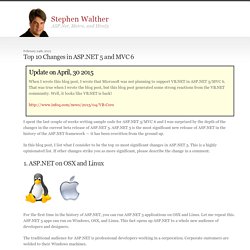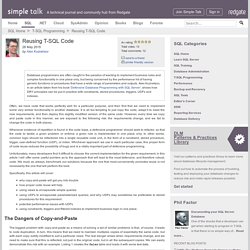

Being A Developer After 40 — Free Code Camp. Being A Developer After 40 (This is the talk I have given at App Builders Switzerland on April 25th, 2016.

The slides are available on SpeakerDeck and at the bottom of this article.) (A version in Russian is available in Habrahabr.ru.) Hi everyone, I am a forty-two years old self-taught developer, and this is my story. GitHub - toddmotto/public-apis: A collective list of public JSON APIs for use in web development. SOLID architecture principles using simple C# examples. Contents Introduction I know there are 1000’s of articles on this subject and every month 10 new articles around SOLID would be injected more.

My goal of writing this article is to understand SOLID with simple C# examples. Any improvements on this article comment box is open below.
Getting Started with OWIN and Katana. Open Web Interface for .NET (OWIN) defines an abstraction between .NET web servers and web applications.

By decoupling the web server from the application, OWIN makes it easier to create middleware for .NET web development. Also, OWIN makes it easier to port web applications to other hosts—for example, self-hosting in a Windows service or other process. OWIN is a community-owned specification, not an implementation. Using Let's Encrypt with IIS on Windows. Let's Encrypt is a new open source certificate authority that promises to provide free SSL certificates in a standardized, API accessible and non-commercial way.

If you've installed SSL certificates in the past, you're probably familiar with the process of signing up for a certificate with some paid for provider and then going through the manual process of swapping certificate requests and completed requests. Let's Encrypt is based on set of open service APIs that can be implemented on any platform and create certificates for Web servers including IIS. This seems like a fabulous idea, given that securing your site if you have any sort of authenticated access is an absolute requirement. It's not so much the money that's a problem since basic SSL certificates these days even from paid providers are relatively cheap (I use DnSimple both for domain management and SSL certificates), but the fact that you can completely automate the process of SSL creation and management is a huge win. Yay! Learn JavaScript: — JavaScript Scene. There are so many JavaScript resources available out there, it’s hard to understand how much of it overlaps and how much is redundant.

Not to mention the process of weeding out bad information. Most JavaScript learning resources neglect two of the most important topics in JavaScript: prototypal inheritance and functional programming. There are many possible paths, several good paths, but few great paths. 12 tips to increase the performance of ASP.NET application drastically – Part 1. This is a guest post by Brij Bhushan Mishra, a Microsoft MVP-ASP.NET/IIS , C# Corner MVP, CodeProject Insider, Former CodeProject MVP, CodeProject Mentor, and Platinum Member at CodeProject .

He has around 6 years of experience as a Sr. Developer/Architect and a passion about computers since childhood. Building web application and hosting it on a web server is insanely easy with ASP.NET and IIS. 12 tips to increase the performance of ASP.NET application drastically – Part 2 - User Experience Guidance. This post is second part of my previous post where we discussed six tips to improve the performance of ASP.NET applications.

In this post, we are going to discuss six more tips that could be another round a booster for your application performance. The link of previous post is below. 12 tips to increase the performance of ASP.NET application drastically – Part 1.
VS.Net/Tooling. Front-end. Android Dev. Entity Framework. Top 10 Changes in ASP.NET 5 and MVC 6. Update on April, 30 2015 When I wrote this blog post, I wrote that Microsoft was not planning to support VB.NET in ASP.NET 5/MVC 6.

That was true when I wrote the blog post, but this blog post generated some strong reactions from the VB.NET community. Well, it looks like VB.NET is back! I spent the last couple of weeks writing sample code for ASP.NET 5/MVC 6 and I was surprised by the depth of the changes in the current beta release of ASP.NET 5. Introducing Source Templates. ReSharper’s Live Templates are a very powerful way of generating code.

Type the name of a template, hit Tab or select the template from the code completion list, and the text template is expanded and inserted into the editor. Any using statements are automatically added, the code is reformatted and you can tab between interactive, editable fields. To make them even more powerful, each field can be bound to a macro that will provide a code completion list of items that are generated dynamically, or taken from the surrounding context. For example, the nguid template expands to a newly generated GUID, shown in several formats in a completion list. Other macros will invoke smart completion, suggest a variable name, return the name of the file and so on. Reusing T-SQL Code. Database programmers are often caught in the paradox of wanting to implement business rules and complex functionality in one place only, but being concerned by the performance hit of having generic functions or procedures that have a wide range of parameters and outputs.

Alex Kuznetsov, in an article taken from his book 'Defensive Database Programming with SQL Server', shows how DRY principles can be put in practice with constraints, stored procedures, triggers, UDFs and indexes. Often, we have code that works perfectly well for a particular purpose, and then find that we need to implement some very similar functionality in another database. It is all too tempting to just copy the code, adapt it to meet the new requirements, and then deploy this slightly modified version of the same code.